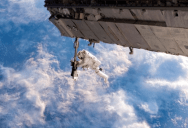When In Space, How Do You Know Which Direction Is Up? Space Agencies Have Put A Lot Of Effort Into Answering This Simple Question.

For most people, knowing which direction is up and which direction is down is just something that comes naturally.
This is primarily due to the fact that we are able to sense the constant pull of gravity toward the Earth, which we associate with being down.
In addition, the whole world around us is oriented in the same way, so using our eyes we are able to instantly confirm what we feel from gravity.
What happens, however, when we enter micro-gravity?
Most people have had a small taste of what it is like when our body experiences a significant drop in gravity.
Whether it is on an airplane that drops quickly due to turbulence, or a roller coaster, we get that momentary feeling of floating that can be very disorientating.
What very few people have experienced, however, is a sustained period of time when there is little to no feeling of the pull of gravity.
This is what astronauts have to adapt to every time they go on a mission.

Once people get far away enough from Earth, the amount of gravity present is not something that they can feel. When this is the case, any direction could be up, down, or side to side.
Even on places like the International Space Station (ISS), where there is still significant gravity, this can happen because the station is falling so fast around the Earth that it negates our ability to sense gravity.
Fortunately, space agencies have come up with a number of different ways to adapt by using our eyes as the primary method of determining up and down.
On the space station, for example, the vast majority of the lights onboard are mounted on one side of the station. Since humans are used to light coming from the sky, we naturally consider that up.
To help with that further, all the instruments, signage, and other things that the astronauts work with on a daily basis are oriented in such a way as to help confirm that the direction the light is coming from is up.
In 2010, the space station was upgraded with a module called the cupola, which has seven large windows to provide a panoramic view of the Earth.
This not only provides beautiful views, but it naturally helps the astronauts associate that direction with down. Since the space station rotates at a rate to keep these windows facing the Earth throughout its orbit.
This also helps to provide a sense of stability that would not be possible if the windows were spinning rapidly, sometimes showing the Earth, other times the moon, other times the sun, and still other times the blackness of space.

So, despite millions of years of evolution getting humans used to relying on gravity to determine up and down, we have found very effective ways to adapt to life in space.
This will be very useful should we ever become a true spacefaring race.
If you thought that was interesting, you might like to read about a second giant hole has opened up on the sun’s surface. Here’s what it means.

Sign up to get our BEST stories of the week straight to your inbox.




